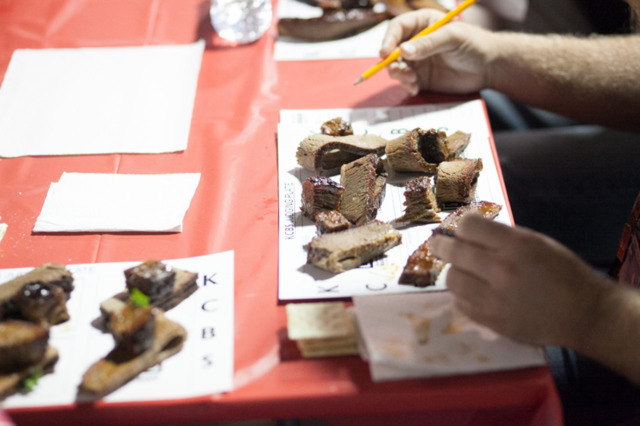What it’s like to compete in the American Royal World Series of Barbecue
Published on October 25, 2016 | Category: Press

By April Fleming
“We end up spending three to four days in a parking lot. It’s the only time we get to see some of our friends throughout the whole year.”
In only one context is that a description of ecstasy rather than a half-remembered bad dream: the American Royal World Series of Barbecue.
Todd Johns of Plowboys Barbeque is the describer in this case, and he has every reason to make the Royal sound good: Plowboys was the overall grand champion at the 2009 Invitational, the open-reserve champion in 2010, and won grand champion awards for its brisket in 2009 and its pork in 2008. But even those who have gone home without ribbons or trophies will tell you it’s a big deal: a party and a kind of family reunion, set against the backdrop of livestock shows, cooking demonstrations, live music, with some 600 teams competing (including a record 20 international teams representing 11 countries) in the flagship food events. Organizers expect 50,000 to attend the October 26-30 event.
This despite the event’s somewhat ignominious move from its longtime location at Kemper Arena in the West Bottoms, first to Arrowhead Stadium (after a memorable spat with the city of Kansas City, Missouri, a few years back) and now to the Kansas Speedway, in Wyandotte County.
“What [competing at Arrowhead] proved to everyone is that you can pick up the American Royal Barbeque and move it out of the West Bottoms and it is still at its heart the same,” Johns says. “The pavement has changed. I think for me and a lot of my friends, we’re still as excited this year as we were the year before.
“People from New England, California, Florida,” he adds. “The American Royal is the one time that we get to sit down and catch up, handshakes and hugs. For many of us, that’s the most important thing.”
Give or take the meat, of course.
Johns explains that each team cooks about 120-150 pounds of meat per contest — two to four pork butts, three to six slabs of ribs, one or two dozen pieces of chicken, two whole briskets. Participants must arrive at the event with everything they plan to use. But a truckload of gear and flesh and the will to win aren’t necessarily a match for the intensity of competition.
“There are a couple of different experiences, depending what your weekend looks like,” Johns says. Some are entered in the invitational, some the open, and some both. “For the teams that are cooking the invitational and the open, you’re cooking in two very important back-to-back contests. By the time you’re starting your turn-ins for the invitational, you’re starting your food for the open. They have to pace themselves and be focused.”
The spectators have to worry slightly less, as long as they remember that it’s more about looking and smelling than about tasting the true competition barbecue. Food trucks and other vendors will have snacks available, but the only way to eat as the judges do is to befriend the competitors (many of whom will gladly share the fruits of their labor) or to purchase Royal Tour tickets for Friday or Saturday, during which some samples are provided.
The invitational and open competitions take place Friday and Saturday. Single-day spectator tickets are available starting at $23, with Royal Tour tickets going for $40. (See americanroyal.com.)
To read the full article go to http://www.pitch.com/food-drink/blog/20838437/what-its-like-to-compete-in-the-american-royal-world-series-of-barbecue-plus-the-weeks-restaurant-events.